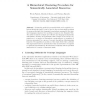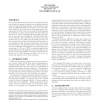CDVE
2007
Springer
14 years 5 months ago
2007
Springer
Semantic Web Services are the key technology providing services for the users’ convenience in the semantic web environment. Many companies in various fields are researching and d...
CAISE
2007
Springer
14 years 5 months ago
2007
Springer
In this paper, we introduce a semi-automatable method aimed to find the business multidimensional concepts from an ontology representing the organization domain. With these premis...
AIIA
2007
Springer
14 years 5 months ago
2007
Springer
Abstract. A clustering method is presented which can be applied to relational knowledge bases. It can be used to discover interesting groupings of resources through their (semantic...
ADAPTIVE
2007
Springer
14 years 5 months ago
2007
Springer
Ontologies and reasoning are the key terms brought into focus by the semantic web community. Formal representation of ontologies in a common data model on the web can be taken as a...
WISE
2007
Springer
14 years 5 months ago
2007
Springer
The increasing number of personal digital photos on the Web makes their management, retrieval and visualization a difficult task. To annotate these images using Semantic Web techno...
WETICE
2007
IEEE
14 years 5 months ago
2007
IEEE
A new application of tuple-space-based coordination systems is in knowledge communication and representation. This knowledge is being published on the Web (the so-called “Semant...
ICTAI
2007
IEEE
14 years 5 months ago
2007
IEEE
The goal of Semantic Web research is to transform the Web from a linked document repository into a distributed knowledge base and application platform, thus allowing the vast rang...
ICECCS
2007
IEEE
14 years 5 months ago
2007
IEEE
Semantic Web Services, one of the most significant research areas within the Semantic Web vision, has attracted increasing attention from both the research community and industry...
ICDE
2007
IEEE
14 years 5 months ago
2007
IEEE
Ontologies have been shown to be beneficial for representing domain knowledge, and are quickly becoming the backbone of the Semantic Web. The need for ontology ranking techniques ...
IAT
2007
IEEE
14 years 5 months ago
2007
IEEE
Agent training techniques study methods to embed empirical, inductive knowledge representations into intelligent agents, in dynamic, recursive or semi-automated ways, expressed in...



